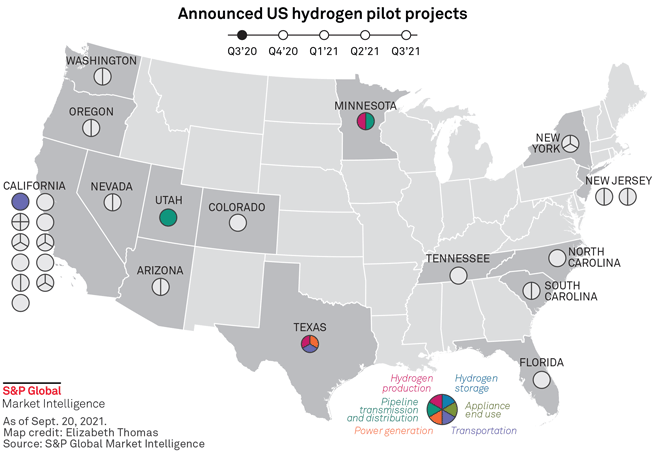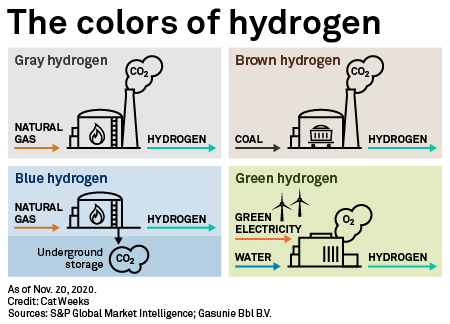Featured Topics
Featured Products
Events
S&P Global Offerings
Featured Topics
Featured Products
Events
S&P Global Offerings
Featured Topics
Featured Products
Events
S&P Global Offerings
Featured Topics
Featured Products
Events
Financial and Market intelligence
Fundamental & Alternative Datasets
Government & Defense
Banking & Capital Markets
Economy & Finance
Energy Transition & Sustainability
Technology & Innovation
Podcasts & Newsletters
Financial and Market intelligence
Fundamental & Alternative Datasets
Government & Defense
Banking & Capital Markets
Economy & Finance
Energy Transition & Sustainability
Technology & Innovation
Podcasts & Newsletters
10 Mar, 2022
Hydrogen pilot project updates from gas utilities show that the industry is starting to execute on its plans to demonstrate the fuel's ability to decarbonize distribution systems.
Some of the more than two dozen projects announced since 2020 are preparing to get underway, while others are already producing data and yielding lessons for operators, according to S&P Global Commodity Insights' review of quarterly earnings conference calls. The opening months of 2022 also saw one of the sector's hydrogen leaders, Southern California Gas Co., ramp up its commitment to the low-carbon fuel beyond pilot projects.

On Feb. 17, SoCalGas announced it aims to build a dedicated hydrogen pipeline system in the Los Angeles area. The Angeles Link, billed as the largest green hydrogen infrastructure network in the nation, would be part of SoCalGas' effort to develop a green hydrogen hub in the Los Angeles Basin.
The support for the project among various California stakeholders illustrates that "clean molecules have a big role to play in this energy transition," Kevin Sagara, utilities group president at parent company Sempra, said during a Feb. 25 call.
Hydrogen advocates have long said dedicated pipelines will be necessary to link supply and demand once the market achieves scale. Most gas utilities, including SoCalGas, have focused on blending hydrogen into existing gas infrastructure. That strategy is cost-effective, but today's gas grid can only handle limited hydrogen volumes without compromising pipeline integrity or end-use appliances.
Hydrogen blending projects advance
Dominion Energy Inc. is continuing to pilot hydrogen blending in Utah. Based on early assessments, the company's distribution system can handle at least a 5% blend of hydrogen, and potentially up to 10%, without adverse impacts on appliance performance, leak surveys, system safety or secondary emissions, Dominion Chairman, President and CEO Bob Blue said during a Feb. 11 call.
Hydrogen blending is one pathway through which Dominion aims to achieve its newly announced goal of reaching net-zero Scope 3 greenhouse gas emissions, which are tied to ratepayers' gas consumption, Blue said.
CenterPoint Energy Inc. is preparing to start up its green hydrogen blending pilot in the Minneapolis area, CFO Jason Wells said during a Feb. 22 conference call. The company plans to produce green hydrogen for injection into its distribution system at low volumes, allowing it to safely assess the risk of leakage and the impact on pipes and appliances.
The company took delivery of an electrolyzer, which splits water into oxygen and hydrogen, in January and expects the pilot to get underway in the coming weeks, CenterPoint spokesperson Ross Corson said in an email.

As Northwest Natural Holding Co.'s western Oregon pilot project advances, the company has explored blending either green hydrogen or synthetic gas into its system. Northwest Natural has proposed making synthetic gas by pairing green hydrogen with waste carbon, known as methanated hydrogen. Unlike hydrogen, synthetic gas releases carbon when burned, but it is also interchangeable with natural gas in distribution systems, according to Kim Heiting, senior vice president of operations and chief marketing officer at Northwest Natural.
Analysis by Northwest Natural found synthetic gas could be cost-competitive with renewable natural gas if produced at scale at zero-carbon electric power plants, Heiting said during a Feb. 25 call. Asked whether subsidies would be necessary, Heiting acknowledged that synthetic gas projects would likely require federal incentives to drive down hydrogen costs.
Power generation pilot yields gas distribution lessons
During the reporting period, Chesapeake Utilities Corp. announced it successfully completed its hydrogen blending pilot project at a Florida combined heat and power plant. On the power generation side, Chesapeake is validating the project's emissions reductions and assessing the blend's impact on the plant's gas turbine and other equipment. The company plans to replace the turbine in 2022 with one capable of handling a 20% hydrogen blend, Chesapeake President and CEO Jeff Householder said during a Feb. 24 call.
But the company also designed the program to refine the practices necessary to safely inject hydrogen into a gas distribution system. It injected hydrogen into a modified interconnection point and delivered the gas blend into the plant through existing steel service mains.
"This was an important first step in demonstrating that hydrogen can play a significant role in providing lower-carbon energy options to industrial customers," Householder said. "We believe there are numerous opportunities to provide hydrogen to assist customers in their emissions reduction efforts."
WEC Energy Group Inc. announced it will pilot hydrogen blending at one of its gas-fueled reciprocating internal combustion engine units in Michigan's Upper Peninsula. The plan is to pilot a maximum 25% hydrogen blend in the power plant, WEC Executive Chairman Gale Klappa said during a Feb. 3 call.
The company is optimistic the project will demonstrate that hydrogen, when paired with reciprocating internal combustion engine technology, "could be a major player going forward in decarbonizing the economy," Klappa said.
S&P Global Commodity Insights produces content for distribution on S&P Capital IQ Pro.